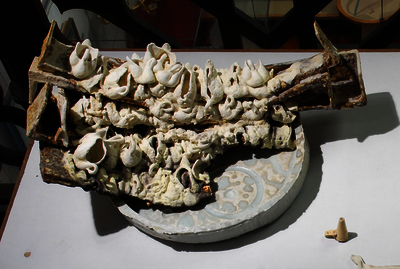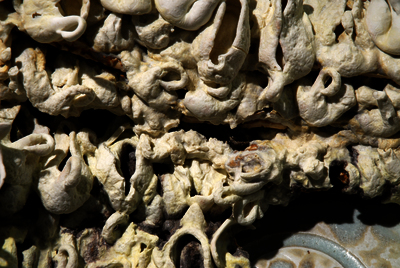BROWNSWORD, Neil (2015) Trinket. Exhibited in -Re-reanimate, Repair, Meld and Mend. [Artefact]
Re- reanimate, Repair, Meld & Mend. Invitation .jpg - Supplemental Material
Restricted to Repository staff only
Available under License Type All Rights Reserved.
Download (651kB) | Request a copy
![[thumbnail of Trinket, (2011-2014) ceramic, 52 x 40 x 27cm]](https://eprints.staffs.ac.uk/5323/2.hassmallThumbnailVersion/1.%20Trinket%2C%20%282011%20-%2014%29%20ceramic%2C%2052%20x%2040%20x%2027.jpg)

1. Trinket, (2011 - 14) ceramic, 52 x 40 x 27.jpg - Supplemental Material
Available under License Type All Rights Reserved.
Download (828kB) | Preview
![[thumbnail of Trinket, detail (2011-2014) ceramic, 52 x 40 x 27cm]](https://eprints.staffs.ac.uk/5323/3.hassmallThumbnailVersion/1.1.%20Trinket%2C%20detail%20%282011%20-%2014%29%20ceramic%2C%2052%20x%2040%20x%2027%20.jpg)

1.1. Trinket, detail (2011 - 14) ceramic, 52 x 40 x 27 .jpg - Supplemental Material
Available under License Type All Rights Reserved.
Download (4MB) | Preview
Abstract or description
Dissemination context:
Curated by ceramic artist Paul Scott, this exhibition featured works from various artists concerned with the re-use and reanimation of existent (often devalued or discarded) cultural material. Trinket (2011- 2014) comprised of redundant bone china objects salvaged from a former ceramic factory’s in Stoke-on-Trent, which were resubmitted back to the kiln and fused together through excessive heat to create abstract amalgams.
Other exhibiting artists included: Michael Brennand-Wood, Neil Brownsword, David Clarke, Robert Dawson, Bouke de Vries, Steve Dixon, Amy Douglas, Jenni Dutton, Matthew Harris, Bridget Harvey, Charlotte Hodes, Gitte Jungersen, Carol McNicoll, Livia Marin, Irene Nordli, Caroline Slotte, Linda Sormin, Hans Stofer & Jacy Wall.
| Item Type: | Artefact |
|---|---|
| Additional Information: | Trinket (artefact) By the 1800’s the six towns that constitute Stoke-on-Trent dominated world pottery production. As its industrial infrastructure grew, an incredible concentration of technical and creative expertise accumulated in the area. Paradoxically, recent decades have seen centuries of this cultivated knowledge being relocated to the Far East, reducing labour costs in some instances by 70%. Company investment in advanced production technology has further contributed to a massive reduction of an indigenous work force and the closure/ demolition of once prevalent sites of historic manufacture. With the ever-changing tide of fashion, the European market has been unable to compete with the saturation of cheap imports. In 1948 79,000 people were employed in the North Staffordshire ceramics industry, today there remains less than 7000. The now redundant wave of highly skilled employees who trained Indonesian and Chinese workforces (paid on average one tenth of the UK annual salary) on behalf of the likes of once dominant conglomerates, find themselves with little industry left to re-apply their specialist knowledge. What happens when such incredible ‘tacit’ expertise finally disappears from the locale, and goods overseas begin to inevitably rise in cost as workers demand more pay and better working conditions? My compulsion to convey the ensuing effects of globalization upon this heritage economy is made manifest through the artistic intervention of artefacts and remnants recovered from redundant factories. This displacement of an industrial community is embodied through a range of strategies and speculative practices that explore fragmentation, the dissolution of form and through the deliberate disabling of my own skill base. Abandoned wares are appropriated and sometimes transformed through excessive heat to recall 18th century wasters - physical testimony to the sheer determination in honing firing technologies to achieve product perfection. To further eulogise this anonymous dexterity and tacit intelligence, clay detritus that speaks of judgements essential in negotiating ‘success’ within various areas of organised labour, is salvaged from the factory production line and made permanent through firing. Momentary imprints retained in these by-products possess a vigour and expression alien to the standardisation of mass production, where evidence of human contact is deemed an imperfection. The resultant assembly of these vestiges of labour does not seek to sentimentalise past glories but attempts to highlight the extent of what is going and what has gone; to honour the role of this indigenous labour and raise greater awareness of its future potential and ultimate sustainability. |
| Faculty: | School of Creative Arts and Engineering > Art and Design |
| Event Title: | Re-reanimate, Repair, Meld and Mend |
| Event Location: | Bluecoat Display Centre, 50-51 Bluecoat Chambers, College Lane Entrance, Liverpool, Merseyside, L1 3BZ |
| Event Dates: | 10 October – 14 November 2015 |
| Depositing User: | Neil BROWNSWORD |
| Date Deposited: | 06 Jun 2019 10:37 |
| Last Modified: | 24 Feb 2023 13:54 |
| URI: | https://eprints.staffs.ac.uk/id/eprint/5323 |

 Tools
Tools Tools
Tools